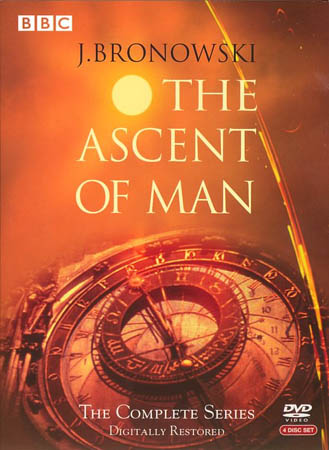 The Ascent of Man |
Dr. J.Bronowski begins this story, our story, five million years ago with the emergence of Australopithecus africanus, ancestors to the human race, and continues through our modern adventures into the Quantum World. The Human Race’s social, architectural, agricultural, metallurgical, and scientific accomplishments are all catalogued with rich and wonderful detail. Although slightly over 400 pages, the book is a fairly quick read, as each chapter is packed with photographs and illustrations. All concepts are kept simple for the layman, and no former knowledge of any of these things is required, because Dr. Bronowski will explain their significance from his enlightened perspective and help us to see their importance in our common history as a whole.
From lemurs to apes to foraging humans, Bronowski then follows a current-day nomadic tribe for a year, illustrating how the demands of their lifestyle are prohibitive to advanced culture. He then follows our early agricultural societies, and the cities that formed at their epicenters. These social constructs then fell prey to nomadic bandits, seeking to pillage what the farmers had amassed, and war was born.
Bronowski conveys historical events with scientific insights that were absent to those that lived through them. Civilization’s movement from the Copper Age to the Bronze Age is explained through the molecular composition of these materials and why one was superior to the others. People living in these ages had no atomic theory, they simply found mixing two weak metals, copper and tin, produced a strong metal, bronze.
The monotheistic religions are treated evenhandedly, with all of the contributions and obstacles they have presented to civilization’s rise. Christianity’s adoption of Ptolemy and Aristotle’s heathen ideas is later contrasted with its persecution of scientific minds such as Galileo. Islam’s contributions to architecture and navigation are viewed as a direct result of its religious requirements.
Every advance is explained in the context of what has come before it. Great Minds and shifting paradigms create the environment for the next generation of accomplishments. Lifestyles, architecture, metallurgy, and scientific discovery are all explained as evolving entities, levels of improvement are laid on the stack of all that has come before them. The Greek Column becomes the Roman Arch becomes the Arab Dome becomes the Gothic Arch, each structure an enhancement on its predecessor, reaching ever higher into the air.
Through Dr. Bronowski’s eyes we see the constant improvement of the human condition. Individual civilizations fall victim to recidivism from time to time, but overall the human race as a whole is constantly moving on to greater things. These are not randomly emergent phenomenon, but explained through the qualities and virtues homo sapiens’ possess that brought us to this point. The reader cannot help but come away from this book with a sense of awe and admiration for our Civilization and a sense of positivism for the species Homo Sapiens.
Note: Some readers will immediately and justifiably be put off by the antiquated and patriarchal term, “Man,” used in the book’s title. This is not indicative of any sexism on Dr. Bronowski’s part, in fact, readers will find the author makes some of the most compelling arguments for equality between the sexes ever published. The terminology is considered sexist today because we use the more accurate descriptive “Human Race” vice “Mankind,” but it is important to remember that Dr. Bronowski’s lexicon was standard for his time, before society became more politically sensitive.
Also Note: This book has been out of print for some time, but this is a good thing as you can now obtain a used copy from Amazon for under $2.
See Also: I highly recommend reading this book and then playing Sid Meyer’s “Civilization III.” It’s like reading theory and putting it into practice.